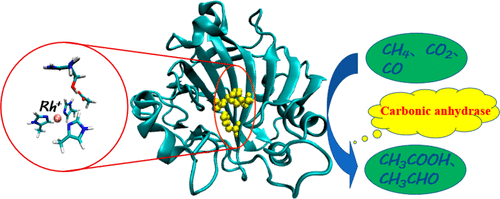当前位置:
X-MOL 学术
›
Organometallics
›
论文详情
Our official English website, www.x-mol.net, welcomes your feedback! (Note: you will need to create a separate account there.)
Catalytic Coupling of CH4 with CO2 and CO by a Modified Human Carbonic Anhydrase Combined with Oriented External Electric Fields: Mechanistic Insights from DFT Calculations
Organometallics ( IF 2.8 ) Pub Date : 2020-12-09 , DOI: 10.1021/acs.organomet.0c00676 Denghui Ma 1 , Hujun Xie 2 , Zexing Cao 1
Organometallics ( IF 2.8 ) Pub Date : 2020-12-09 , DOI: 10.1021/acs.organomet.0c00676 Denghui Ma 1 , Hujun Xie 2 , Zexing Cao 1
Affiliation

|
The leading edge of biocatalysis is human intervention to expand the specificity of the reactions, so that enzymes can catalyze an impressive range of challenging chemical reactions. Here density functional theory (DFT) calculations were used to explore the catalytic coupling of CH4 with CO2 and CO into value-added chemicals by a rhodium(I)-substituted human carbonic anhydrase [Rh(hCAII)] under the oriented external electric fields (OEEFs), and possible mechanisms and OEEF effects have been discussed. The DFT calculations show that the rate-determining step for the catalytic coupling of CH4 and CO2 into acetic acid is CO2 insertion and the formation of a C–C bond, and the application of OEEF (Fx = +0.0075 au) can remarkably reduce the free energy span from 37.4 to 19.3 kcal/mol. The coupling of CH4 with CO into acetaldehyde has a barrier requirement of below 28.0 kcal/mol. On the basis of the present results, the artificial carbonic anhydrase is very promising for the conversion of carbon-based small molecules with the judicious use of OEEFs.
中文翻译:

修饰的人类碳酸酐酶与定向外部电场的结合,催化CH 4与CO 2和CO的偶联:从DFT计算中获得的机理见解
生物催化的前沿技术是人为干预以扩大反应的特异性,因此酶可以催化一系列具有挑战性的化学反应。在此,使用密度泛函理论(DFT)计算来探索CH 4与CO 2和CO通过铑(I)取代的人类碳酸酐酶[Rh(hCAII)]在定向外部电催化下的偶联反应。领域(OEEF),并讨论了可能的机制和OEEF效果。DFT计算表明,CH 4和CO 2催化偶合到乙酸中的速率决定步骤是CO 2的插入和C–C键的形成以及OEEF(Fx = +0.0075 au)可以将自由能范围从37.4显着降低到19.3 kcal / mol。将CH 4与CO偶联到乙醛中的阻隔要求低于28.0 kcal / mol。根据目前的结果,通过明智地使用OEEF,人工碳酸酐酶对于基于碳的小分子的转化非常有希望。
更新日期:2020-12-28
中文翻译:

修饰的人类碳酸酐酶与定向外部电场的结合,催化CH 4与CO 2和CO的偶联:从DFT计算中获得的机理见解
生物催化的前沿技术是人为干预以扩大反应的特异性,因此酶可以催化一系列具有挑战性的化学反应。在此,使用密度泛函理论(DFT)计算来探索CH 4与CO 2和CO通过铑(I)取代的人类碳酸酐酶[Rh(hCAII)]在定向外部电催化下的偶联反应。领域(OEEF),并讨论了可能的机制和OEEF效果。DFT计算表明,CH 4和CO 2催化偶合到乙酸中的速率决定步骤是CO 2的插入和C–C键的形成以及OEEF(Fx = +0.0075 au)可以将自由能范围从37.4显着降低到19.3 kcal / mol。将CH 4与CO偶联到乙醛中的阻隔要求低于28.0 kcal / mol。根据目前的结果,通过明智地使用OEEF,人工碳酸酐酶对于基于碳的小分子的转化非常有希望。

























 京公网安备 11010802027423号
京公网安备 11010802027423号